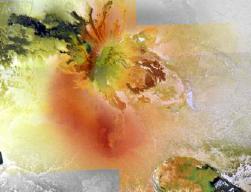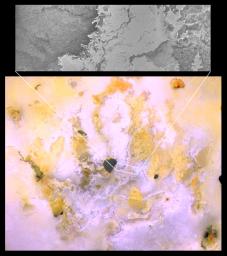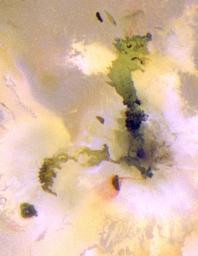Lava Flows
Io's volcanism does not produce steep-sided volcanic mountains. The volcanic lavas on Io are very fluid, and form relatively low, gently-sloping mountains called shield volcanoes. The lavas may either be silicate, sulfur, or a complex mixture of both . The highest temperature lavas are most likely silicate because sulfur cannot remain liquid above its boiling point. The longest flows, however, may be composed primarily of molten sulfur, which is very fluid.
 This
image shows Culann Patera, which is one of the most colorful
volcanic centers on Io. The central caldera has an
irregular-shaped, scalloped margin and a green floor. Lava
flows are seen to spill out in all directions from the
caldera. The dark, red curving line on the northwest edge of
the caldera may be a crusted-over lava tube feeding the
nearby dark, hot flows of silicate lava.
This
image shows Culann Patera, which is one of the most colorful
volcanic centers on Io. The central caldera has an
irregular-shaped, scalloped margin and a green floor. Lava
flows are seen to spill out in all directions from the
caldera. The dark, red curving line on the northwest edge of
the caldera may be a crusted-over lava tube feeding the
nearby dark, hot flows of silicate lava.
 Most
lava flows on Io are dark, but the channelized lava flow in
this image emanating from Emakong is extremely bright.
Scientists speculate that this lava flow is composed of
sulfur rather than silicate rock. Sulfur can be black, red,
orange or yellow depending on its temperature. The serrated
edges of the flow indicate that it is highly fluid and is
working its way into every crevice over which it travels.
New images show that the lava channel is roofed over in
several places insulating the lava from the freezing
temperatures at the surface and this may allow the lava to
travel longer distances.
Most
lava flows on Io are dark, but the channelized lava flow in
this image emanating from Emakong is extremely bright.
Scientists speculate that this lava flow is composed of
sulfur rather than silicate rock. Sulfur can be black, red,
orange or yellow depending on its temperature. The serrated
edges of the flow indicate that it is highly fluid and is
working its way into every crevice over which it travels.
New images show that the lava channel is roofed over in
several places insulating the lava from the freezing
temperatures at the surface and this may allow the lava to
travel longer distances.
 Lava
flows extend for great distances on Io. The longest,
currently active lava flow in the solar system is
Amirani-Maui, which is more than 250 km (160 miles) long.
The volcanic features Amirani (right) and Maui (left, below
center) at first were thought to be two separate volcanoes.
This new Galileo image, however, shows that Maui is actually
an active lava flow that extends west of the Amirani vent.
Surrounding the Amirani vent are plume deposits of
sulfur-dioxide snow which formed when gases expelled from
the vent, froze and fell back to the surface.
Lava
flows extend for great distances on Io. The longest,
currently active lava flow in the solar system is
Amirani-Maui, which is more than 250 km (160 miles) long.
The volcanic features Amirani (right) and Maui (left, below
center) at first were thought to be two separate volcanoes.
This new Galileo image, however, shows that Maui is actually
an active lava flow that extends west of the Amirani vent.
Surrounding the Amirani vent are plume deposits of
sulfur-dioxide snow which formed when gases expelled from
the vent, froze and fell back to the surface.
Twelve different vents on Io erupt lava at temperatures greater than 2,200 degrees Fahrenheit, and one may be as hot as 3,100 degrees Fahrenheit. Lavas of this temperature have not been found on Earth for the last 2 billion years. Studying volcanic processes on Io may, therefore, provide some insight into Earth's early volcanic history.
Photo Credits: NASA/JPL
